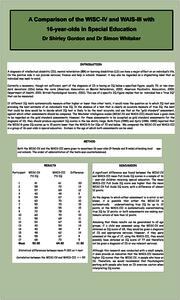A diagnosis of intellectual disability (ID), mental retardation (MR) or Learning Disabilities (LD) can have a major effect on people’s lives. On the positive side it can provide services, finance, help in schools, and can even prevent the recipient from being executed (Flynn 2006; Flynn 2007; Schalock et al 2007). On the negative side it is may be regarded as a stigmatizing label that an individual may seek to avoid (Baroff 1999).
Currently a necessary though not sufficient part of the diagnosis of ID is having an IQ below a specified figure, usually 70, or two standard deviations (SDs) below the norm (American Association on Mental Retardation, 2002; American Psychiatric Association 2000; Department of Health 2001; British Psychological Society 2001). This specification of a specific IQ figure implies that an individual has a “true IQ” that can be measured.
If different IQ tests systematically measure either higher or lower than other tests it would raise the question as to which IQ test was providing the best estimate of an individual’s true IQ. In the absence of a test that is clearly an accurate measure of true IQ, the best that could be done would be to decide which of the many IQ tests is likely to be the most accurate, and take that as the “gold standard” assessment against which other assessment should be compared. The Wechsler assessments, the WISC-IV and the WAIS-III should have a good claim to be regarded as the gold standard assessments. However, for these assessments to be accepted as gold standard assessments for the diagnosis of ID, it requires that they should produce equivalent IQ scores in the low ability range. We compared the WISC-IV and WAIS-III on a group of 16-year-olds in special education. Sixteen being the age group at which both assessments can be used.
Both the WISC-IV and the WAIS-III were given to seventeen 16-year-olds (9 female and 8 male) attending local special schools in counterbalanced order. The results were as follows:
WISC-IV WAIS-III Diff r
Mean Full Scale IQ 53.00 64.82 11.82 .93
In spite of a very high correlation between the two scales there was a highly significant difference between the mean FS IQ on each scale of nearly 12 points (P<.001 on t-test); none of the participants in the study scored higher on the WISC-IV than they did on the WAIS-III. It is therefore clear that either one or both of these assessments is failing to produce an accurate measure of an individuals true IQ. As the degree to which either assessment is in error is not known, it is clearly possible that either the WISC-IV is systematically underestimating true IQ by up to 12 points, or the WAIS-III is systematically overestimating true IQ by 12 points or both assessments are making systematic errors of less than 12 points. Clearly this has implications for the use of a specified IQ figure as a diagnostic criterion for ID.
Summary of abstract
The WISC-IV and WAIS-III were given to seventeen 16-year-olds in special education in counterbalanced order. The mean FS IQ on the WISC-IV was 53.00 and on the WAIS-III it was 64.82 a difference of nearly 12 points. The correlation between the two assessments was .93. It is therefore clear that either one or both of these assessments is failing to produce an accurate measure of an individuals true IQ.
Downloads
Downloads per month over past year
Downloads per month over past year for
"WhitakerComparisonPoster.jpg"
Downloads per month over past year for
"WhitakerComparisonPosterpdf.pdf"

![Poster [thumbnail of Poster]](https://eprints.hud.ac.uk/10546/1.hassmallThumbnailVersion/WhitakerComparisonPoster.jpg)


 CORE (COnnecting REpositories)
CORE (COnnecting REpositories) CORE (COnnecting REpositories)
CORE (COnnecting REpositories)